A mild October extends the late, late colour show
Monday, October 28, 2013
For the third year running we have had a wonderful October - no
frost, plenty of the "right sort" of rain, many warm days and
nights and especially early on, some bright sunshine. All
this has provided perfect growing conditions for a wide range of
later flowering plants and also some re-blooming on early season
perennials like lupins, campanulas and anthemis.
Dahlia "Witteman's Best" OK you have seen it
before but it is so fabulous and long flowering it deserves
another mention!
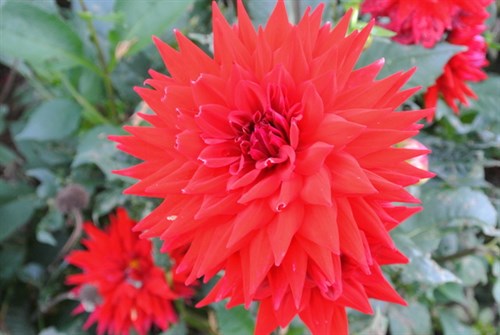
Annuals too have stayed in flower for much longer than usual.
The lawns are green and lush, there are still plenty of butterflies
and bees (and wasps!) and the veggies are abundant. However no
autumn colour on trees and shrubs until the last 2 weeks - the
legacy of a very late Spring continues to be felt in spite of the
fine summer, and many plants are still behind where they would
normally be at this time of year. But who cares? it makes the
winter still feel a long way off even though the frosts could come
overnight and the never ending colour show will come to an abrupt
end.
A moist and misty day showing off the Paddock borders in
a new light. Atmospheric but melancholy too as the garden year
comes gently to the end.
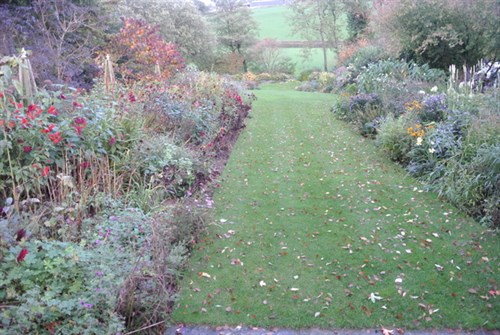
In the countryside you have to be prepared however seductive the
weather may be and October is my main woodcutting time continuing
on from a September start The loan of a large logspliiter from Rob
my lawns guru has been much appreciated making light work of even
the largest logs over 2 feet in diameter

Weather
A fine month. Notable has been the incidence of warm nights with
minima of just 16C on several occasions and most other nights above
10C. Just one rogue night (10th) when if dropped to 0.3C in the
Paddock Garden. (House Garden as always warmer at 3C). Tender
plants covered with miles of horti fleece and that plus rising
overnight temperatures meant there was no plant damage. Warmest
daytime max 21C on the 2nd. Last week of the month cooler and much
wetter bringing rivers up to their highest levels since March. The
"Great Storm" in the early hours of 28th missed our part of Wales
thank goodness!
"Miles" of horti fleece over the precious tender plants
in the red border. I wonder how long they would flower if we had no
frosts. Most of the salvias are just getting into their
stride!

Garden update
Most of my comments from September News could be applied equally
to October, particularly in the first half of the month. Dahlias
rampant (especially the species form d. merckii) and responding
with ever more flowers to regular dead heading (which definitely
extends their flowering), as were cosmos, annual rudbeckias and
zinnias. New arrivals included hesperantha formerly schizostylis
(Kaffir Lily) "Pink Princess" especially good, saxifraga fortuneii
in variety smaller than usual and less floriferous, a late show
from clematis including "Blue Belle" (at last), tibetana ssp
vernayi, and seed grown texensis cross.
Saxifraga fortuneii "Rubrifolia". I can't recommend this
group enough for a shady spot that does not dry out and plenty to
choose from for flowers September to the frosts.
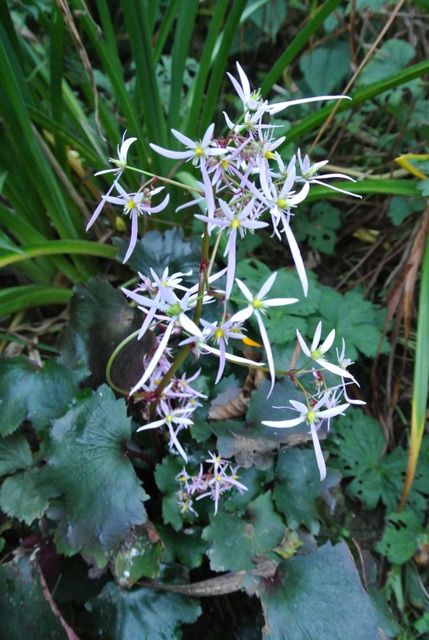
Hardy chrysanthemums are good value for October and one of the
best in the Red Border is the delightful "Ruby Mound" with flower
packed heads and no yellow eye as many of this group have. Cyclamen
hederifolia is now showing its new leaves in a bewildering range of
patterns and shapes (no two plants are ever quite the same),
which will last all winter long after the flowers have faded, but
the first of the cyclamen coum are now showing flower in the
bud.
Chrysanthemum "Ruby Mound" Koreana Group
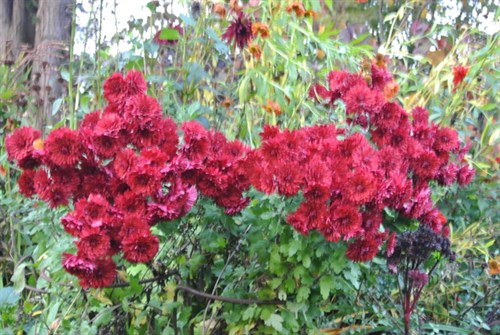
And a very precious and old chrysanthemum "Emperor
of China" Koreana Group. A lovely shade of pale pink with quilled,
spoon edged petals.

Good leaf colour on hydrangeas, particularly the serratas many
of which turn wonderful shades of deep purple, underated perhaps
for this particular quality and most still have a few flowers too -
a good value border shrub.

And a hydrangea at it's best in autumn , h.macrophyll
"Merveille Sanguine". In a less shady spot the flowers and leaves
are much darker
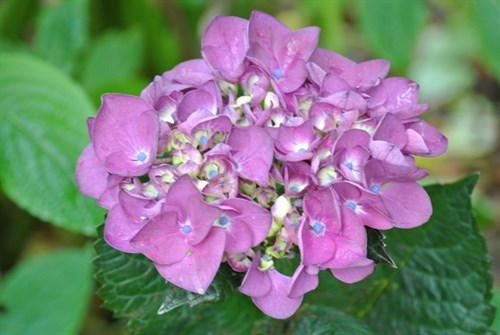
Other trees and shrubs slow but colour is good at last on
sorbus, euonymus alata, cornus and cercis canadensis "Forest
Pansy".
Cercis canadensis"Forest Pansy". These large shrubs are
expensive and slow growing, this one is nearly 20 years old but
only about 10 feet tall - well worth the money when you see them
like this.
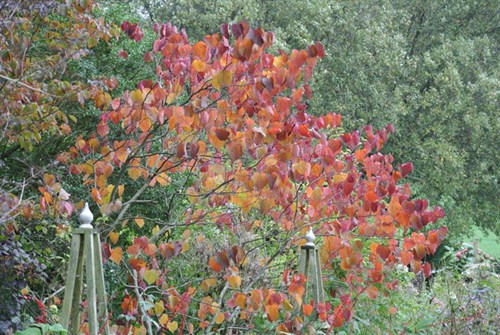
It seems though that as soon as the colour starts the leaves
begin to drop so perhaps not a memorable year for autumn leaves. An
unexpected source of leaf colour comes from hostas which have held
onto their leaves very late this year and now many are turning to a
wonderful shade of butter yellow, being especially impressive in
the American style hosta bed alongside th Paddock Pond. The stand
of hosta "Frances Williams" in shade by the bridge over the stream
still looks as good as it did 2 months ago when I featured it in my
August News. Amazing!
Lovely leaf colour on Roscoea hybrid from "Red
Gurkha" and "Brown Peacock" (shown in flower in September News). It
is beautifully set off by the zig-zag leaves of persicaria
macrocephala "Purple Fantasy" another shade lover like its
companion.
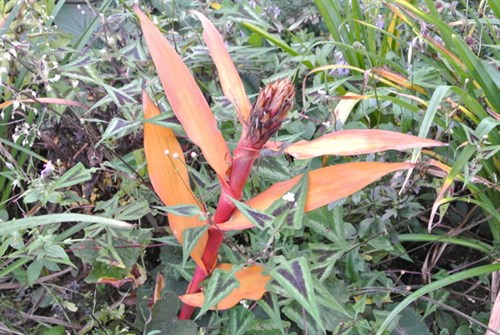
I have taken many cuttings of tender plants and most have struck
well and are growing away nicely to make good plants for next
summer. Still time to do this if you haven't made a start.
Tender plants in pots outside have been moved into the tunnels
and benches put up to get as much as possible under protection
before the winter starts. All hardy plants in the nursery placed in
cold frames as most are susceptible in pots out in the open if they
get wet and then frozen.
What's looking good?
And now if you have been wondering what the intriguiging heading
about plants from the Americas is all about, here it is!! Given the
sort of show we have had this year I really wanted to say "Hooray
for Hollywood" but it wouldn't have been quite appropriate because
it's about all of the American continent.
It occurred to me when walking around the gardens a few weeks
ago just how many plants that make a major contribution to our
autumn gardens come from here. Asters, rudbeckias, echinaceas from
North America, salvias, cobaea and brugmansias from central America
and fuchsias and verbenas from South America to name but a few. I
accept that some of these may not be widely planted but here at
Cilgwyn all of them are regular contributors to the autumn scene in
the gardens or tunnels.
Asters en masse in front of the summerhouse
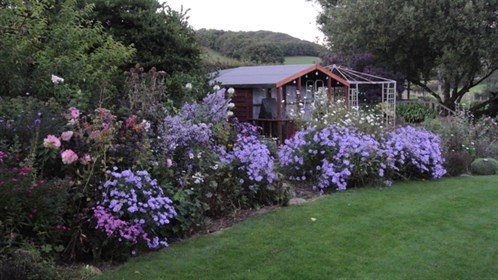
This aster is a bit of a mystery. It came to me as aster
"Photograph" but it looks nothing like any of the desciptions and
pictures I have seen in books and on line. It is truly beautiful
with these long panicles of pale blue flowers looking good
for about 2 months.

If you are a regular reader this plant needs no
introduction - look at all the banner images on this website if you
want to see it in full flower which it does for about 3 months, but
as it fades these long lasting black cones take the place of the
yellow disk flowers.
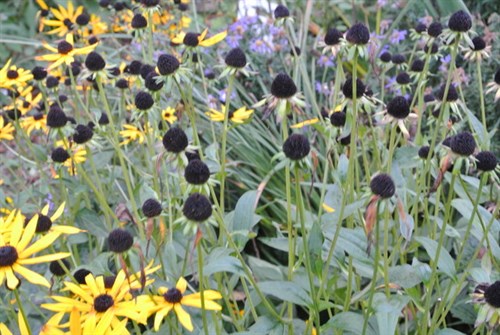
Salvia splendens from Mexico relies on shorter
day length and cooler nights to trigger mass flowering which it
does in spades. 4 feet tall so what a statement in the Red
Border

A really great find this year is the blue salvia
"Amistad" which has been in flower continuously since June. It
looks really good with the white spikes of the tall
sanguisorba
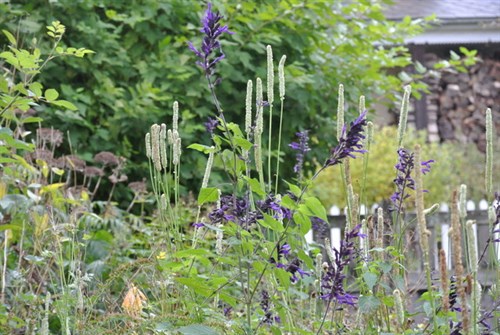
Cobaea scandens, a rampant climber from
central/southern America comes (just) from from seed if sown
early in the year. Flowering usually starts in September and builds
to a mass flowering in October if as this year it stays mild.
Although perennial it is best treated as an annual because in our
climate I have yet to get it through the winter. There is also a
really choice white form that has done well for me in previous
years. Not difficult to see why it is commonly called the "cup and
saucer" vine

Now to a more familiar Central/South American favourite. The
breeders have worked miracles over a few centuries and this is
surely, for my taste, their single best achievement. A superb
flavoured tomato "Rosada" now on its 15th truss in the big tunnel.
Note also the yellow brugmansia in the background. Yes you have
guessed it, another Americas import!!
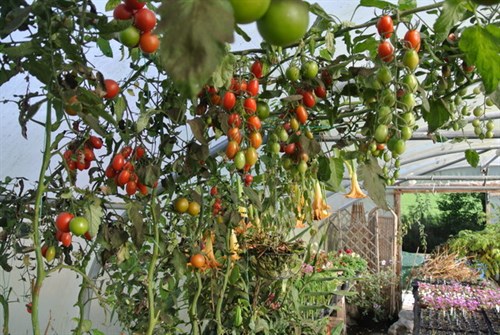
Another polytunnel resident is passiflora rubra
(well that is the name on the label) which responds well to the
protected environment, producing many buds for an extended
show at this time of year. Not bad for a £1 reject from a well
known Garden Centre Group. These bargains often give the greatest
pleasure.

Hardy fucsias are an invaluable selection for late
coulour, relishing in the cooler conditions and moist air.
They also like some shade and we have a growing collection in the
gardens. Most of the name tags have long since disappeared but as
Christopher Lloyd once remarked "Who cares what is - just enjoy
them" !
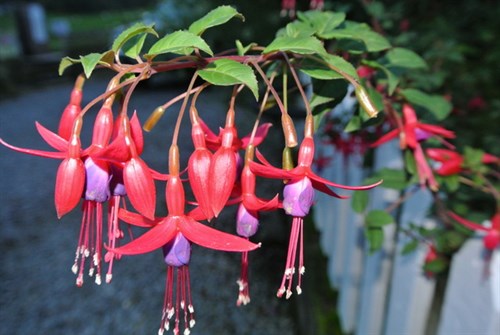
Alstroemerias are as South American as you can get
with many cultivars to choose from. I have found "Selina" to be
very reliably hardy. sturdy, upright and repeat flowering.
They bulk up well but not invasively like their cousins a.
aurantica, a serious thug although quite lovely when in
flower.
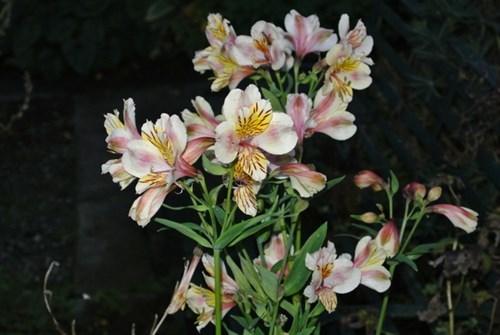
From sea cliffs in Chile comes lobelia tupa. hardy here
with roots protected by the large yew in the Red Border and
flowering from June to November
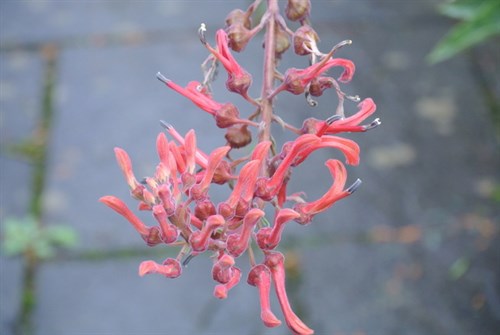
The root vegetables are also wonderful and when roasted
with olive oil and herbs, make a regular appearance on our
evening meal menu. Tonight we had Milan Purple Top Turnip, Swede
"Invitation" clubroot resistant and an excellent cropper, celeriac,
beetroot, carrots, parsnip and salsify an unusual plant which has a
thin tap root and nutty sweet taste. More than 5 a day in one dish
with other side dishes too like the first of the Brussels sprouts
("Crispus") or a savoy cabbage.
On cooler or wetter days the greenhouses and tunnels are a nice
refuge and here there are more tender plants to enjoy which, with
the protection, continue to flourish until later in the year.
Having had this hedychium (ginger) in a pot for 5 years
it was a thrill to see it start to flower for the first time a
couple of weeks ago. "Luna Moth" has been outside all summer
it obviously enjoyed the warmth and recent rains and as soon as it
was moved to the large tunnel it began to flower. It has10
flowering stems on a large plant which will open slowly over the
next few weeks. As an extra bonus it has a wonderful scent which is
more prominant after dark.
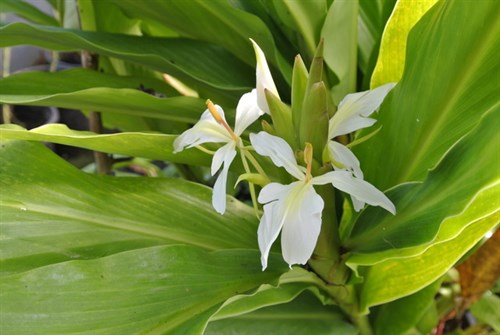
Tender fuchsia boliviana var. alba - no prizes for
guessing where this comes from.
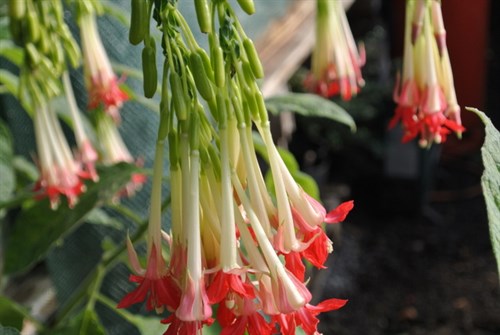
Impatiens kilimanjari x pseudoviola from Africa. Flowers
year round under protection.
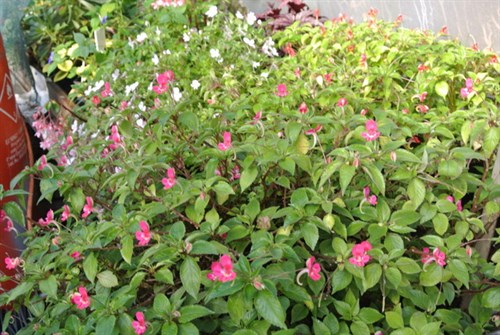
After all the exoitca back to good old Britain and
the last roses of summer "Munstead Wood" from David Austin.
Good scent and repeat but really prickly.
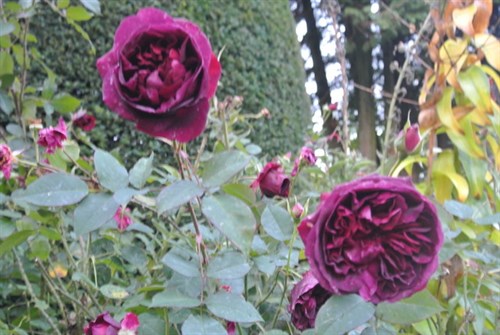
Wildlife and countryside
The highlight this month has been the amount of fruit on native
trees all around us. Acorns, ash keys, rose hips,
blackberries,holly berries, and especially beech mast on the tree
near the tunnels which fires down salvoes every time the wind
blows, bouncing off the plastic like a kettle drum, and if I am
foolhardy enough to go without a hat, on my bald head!
The sweetest blackberries ever on the walk to
Marloes beach (see visits and visitors below)
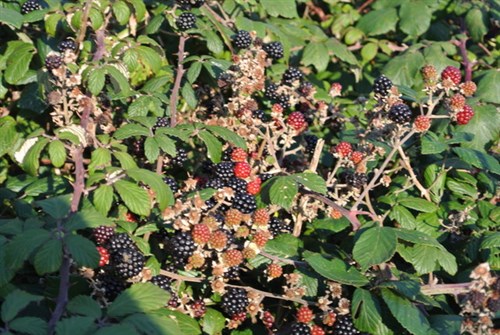
Lovely seed heads on umbellifers on a country lane
in Pembrokeshire

The hazel nuts were long ago raided by grey squirrels but on a
recent visit to Herefordshire I was pleased to learn it has been a
great year for walnuts, which straight from the tree (wet walnuts)
are as far away from Californian walnuts as it is possible to be.
Back to Hollywood at last!
A few rabbits still at large in the gardens but no significant
damage done. Winter bird visitors have not yet arrived but there
are more robins around than I have seen for some time. A
resident sparrowhawk keeps all the smaller birds on their toes and
the blackbirds in particular are more edgy than ever especially at
dusk when they are most at risk.
Visits and visitors
As our visitor season has ended and with less talks this autumn
than for some years we have had the chance to get out and about.
Kiftsgate, Gloucestershire was fabulous as always, The Picton
Garden in Worcestershire holding a National Collection of
Michaelmas daisies was later than usual with many asters
still to come into flower at the beginning of October. Finally our
annual pilgrimage to Hergest Croft Autumn Plant Fair was as good as
ever and although there was wide variety of stalls, few
people attended because of poor weather on the day.
The Picton Garden
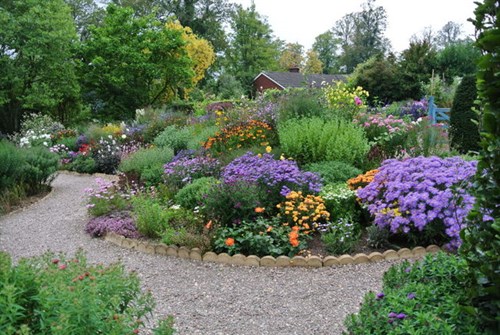
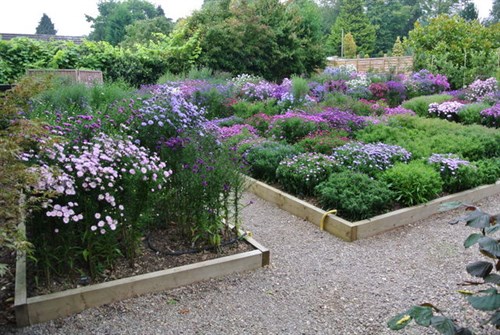
Hergest Croft - note the absence of visitors on
such a dismal day.

After the fair our friends Sylvia and Tony stayed for a few days
and we sought some sun and surf in the far west of Pembrokeshire
and we weren't dissapointed.
High tide at Marloes beach, one of the most westerly in
Pembrokeshire.

Evening sunlight over Skomer, Pembrokeshire,
a fitting way to bring the curtain down on this extended News item
and our gardening year. Nothing to look forward to now but mud,
slush and darkness.
